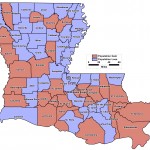In our last posting, we discussed population changes from the perspective of changes in voter registration counts for all 144 legislative districts. In this article, we would like to examine population changes from Census data. This past week, the US Census released interim population estimates showing population changes for all 50 states between April 2, 2010 (the date after the last Census was taken) and July 1, 2013. While this interim count is an estimate, it is useful for tracking population changes throughout the decade to be able to predict future population/demographic changes.
Overall, the Census estimates were, like last year’s, favorable to Louisiana with regards to population growth. Between 2010 and 2013, its population grew 2.0%, and its estimated July 1, 2013 population was 4,625,470. While a 2.0% growth figure does not seem like much, there are two things that are important to remember: (1) the estimate of growth is only for 3 years (as opposed to the 10 year time span that the Census uses), and (2) for the previous three decades, Louisiana saw very little population growth, and as a consequence, it lost two of its eight Congressional seats. If this 2.0% rate of growth were to sustain itself for the remainder of this decade, Louisiana’s 2020 Census population would be 6.3 % higher than it was in 2010 – a growth rate not seen since the 1970s.
If one were to look at the parish level, 36 of its 64 parishes lost population. By and large, those population losing parishes were not adjacent to a metropolitan area, nor were they along a well-traveled major highway. For those parishes gaining population, the epicenter again was in the parishes seeing heavy suburban migration: Ascension, Bossier, Livingston, and St. Tammany Parishes – those parishes have a projected growth rate of more than 10% if you project those population gains into 2020. And these fast growing parishes have been joined since the July 1, 2012 estimate by Lafayette, Tangipahoa, and West Baton Rouge – parishes which happen to be along the I-10/12 corridor between Lafayette and Slidell that has been the epicenter for Louisiana’s population growth.
In the 2012 Census estimates, it was noticed that two of the parishes receiving the greatest amount of destruction from Hurricane Katrina (Orleans and St Bernard) have posted the strongest population gains in the entire state (in fact, 46% of Louisiana’s population growth came from these two parishes alone). That trend continued this past year, as St Bernard’s 16% population increase has been revised upwards to 21%, and Orleans Parish’s 7% population increase has similarly been revised upwards to 10%. While these population gains are certainly impressive, it’s important to put in context: these population gains are most likely a continuing resettlement into these areas.
So why are these Census figures significant? Ultimately, the composition of the US House of Representatives, the state legislature, and local governmental bodies depends on where the population is/how it is distributed. And in the case of the 2013 Census estimates, we calculate that the population growth in Orleans and Saint Bernard Parishes is significant enough for it to “recapture” two (last year, it was one) of the four House seats that were eliminated during the 2011 reapportionment.

